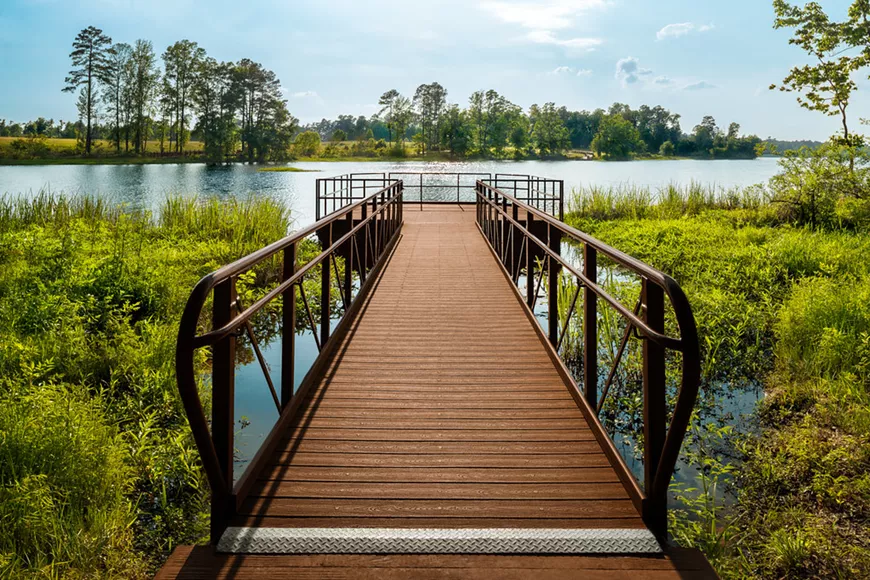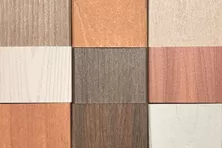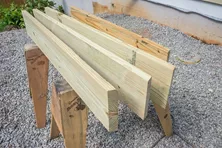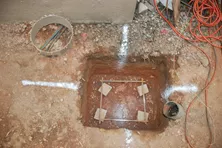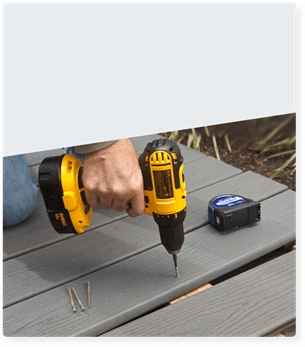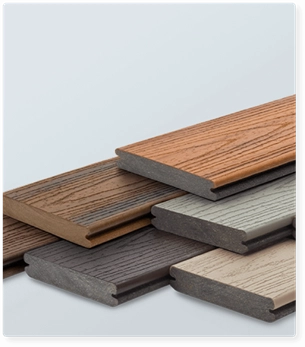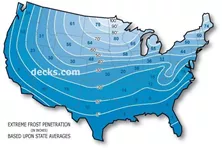Eco Friendly Composite & Wood Decking Options
For many consumers, going “green” is second nature, meaning they factor in a product’s environmental footprint when making purchasing decisions. In selecting eco-friendly decking, the choice isn’t obvious, because each option has environmental advantages and drawbacks, as detailed below. In the end, you’ll have to weigh which factors matter most to you and determine which products will give you the most peace of mind while you enjoy the comfort of your new deck.
Eco-Friendly Decking Option: Composite
Sustainable composite decking—decking made from recycled plastic and reclaimed wood—has tremendous green appeal. It also lasts twice as long as wood and doesn’t need for frequent applications of harsh cleaners, stains, or sealers. Yet not all composite decks are equally green. It depends on how manufacturers source their materials and manufacture their products. Eco-friendly composite decking from Trex, for example, includes 95 percent recycled content, while a competitor’s products have only 80 percent recycled content. Because of its sourcing practices, Trex keeps more than 850 million pounds of plastic film and wood out of landfills each year. In addition, at Trex factories, nearly 100 percent of runoff and refuse is recycled back into the manufacturing line.
Pros of Composite Decking
Composite decking isn’t “natural” like wood, but it is loaded with recycled waste, lasts longer than wood, and doesn’t require seasonal refinishing.
- Less waste. Since composite deck boards are made from recycled materials that are otherwise difficult to recycle, they reduce the amount of waste entering landfills and the larger environment.
- More trees. The wood content of most composite decking is reclaimed material, so there is no need to cut down trees to produce it. That helps preserve natural forests.
- Chemical-free upkeep. Unlike wood, composite decks can be cleaned with regular soap and water and don’t require the use of harsh cleaners or annual applications of stains and/or sealers. This keeps undesirable chemicals out of the water and soil.
- Longer service life. Because composite decking lasts longer than wood, it reduces the need to remove and rebuild decks. This, in turn, keeps scrapped deck materials out of landfills longer and reduces the material and energy inputs needed to construct new decks.
Cons of Composite Decking
While composite decks start off eco-friendly, the deck boards cannot be recycled or reused as compost like wood. Nor are there many uses for the scraps left over from building a new deck.
- No second life. When a composite deck needs replacing, its deck boards cannot be reclaimed for use in other products or applications like wood can.
- Limited repurposing. Every deck requires cutting boards to fit, which produces short lengths that cannot be used on the deck. While some of these short pieces can be repurposed as coasters or used to build planters, outdoor furniture and birdhouses, the amount of scrap usually outweighs your ability to devise projects for it.
Eco-Friendly Decking Option: Wood
Natural wood decking is sustainable because trees can be regrown over and over again. Plus, at the end of their service life, wood deck boards can be recycled into other products, such as mulch, or allowed to decompose naturally. Wood can also be used as fuel to generate electricity. To ensure the wood you’re using is sustainable, look for certifications from trustworthy third parties.
Pros of Wood
Wood is an age-old building material that remains popular and abundant. As for sustainability, it has several advantages.
- Trees grow back. While some natural resources are finite, trees can be replanted and harvested indefinitely.
- Wood has an afterlife. Wood left over from building a deck can be used in other projects. Plus, when a wood deck reaches the end of its service life, the boards can be ground into mulch or used as fuel to generate electricity. If the wood is free of preservatives or coatings, old decking can even be burned in your fire pit.
- Carbon is sequestered. Trees capture carbon as they grow and sequester it in the wood. This removes carbon from the atmosphere, preventing it from becoming a greenhouse gas that could contribute to climate change.
- Wood decomposes. Unlike plastics and composites, wood decomposes quickly, making it easier and less costly to dispose of.
Cons of Wood
Wood decking requires regular maintenance to prevent decay. This typically means cleaning it with a strong detergent once or twice per year and applying a fresh coat of stain and/or sealer every few years. While some old deck boards can be recycled or burned, pressure-treated wood often goes to a landfill.
- Chemically infused. Most wood decks are made of pressure-treated (PT) lumber. It is an inexpensive option that comes with a downside: deck boards infused with anti-rot chemicals and insecticides can be hazardous to your health. As a result, PT boards should not be burned. Even buried in landfills, the deck boards might eventually pose an eco-hazard.
- Detergents, stains, and sealers. While wood decks made from ipe, redwood, and cedar are rot-resistant, they still require regular cleaning and periodic staining and sealing. Few of the detergents and coatings used are considered environmentally friendly.
- Deforestation. Old growth forests and rainforests are getting scarce, and many of them have legal protection. Nonetheless, unscrupulous harvesting still occurs. Make sure the wood you use for your deck, especially if it’s an exotic wood like teak or ipe, is certified by a trustworthy organization, such as the Forestry Stewardship Council.
Natural Wood vs. Pressure Treated
Most natural wood used in decks is cedar or redwood because these species are inherently resistant to rot and insect infestations. Pressure-treated (PT) wood, typically Douglas fir or southern yellow pine, is made rot-resistant by infusing it with insecticides and other chemicals. Nonetheless, cedar outlasts PT lumber. Plus, PT lumber requires more maintenance, including yearly application of stain in some cases. That’s a one-two chemical punch that demotes PT’s eco-friendly ranking. Furthermore. PT wood must be sent to a landfill. It can’t be burned like natural woods. As for redwood, it can last for decades, but because it is sourced from old-growth forests that are difficult to renew, redwood is not very eco-friendly.
Other Eco-Friendly Deck & Patio Alternatives
Aluminum deck boards and PVC deck boards are also available and, like the other options, have pros and cons. Aluminum decking is very long lasting and requires little maintenance, both eco-friendly attributes. Most aluminum decking is powder-coated, a finishing process with a very low environmental impact. At the end of its service life, aluminum decking will have some scrap value and can be recycled into new products.
PVC (polyvinyl chloride) deck boards, typically have cores made of cellular foam or composite material and are capped with PVC on all four sides. It’s a durable material that isn’t recyclable. And because it’s made from petrochemicals sourced from fossil fuels, it’s not considered eco-friendly or sustainable. On the other hand, some PVC deck boards contain recycled materials and a few manufacturers strive to recycle their PVC to keep it out of landfills.
Wood vs. Composite Decking: Which is more Eco-Friendly?
Deciding which decking is more eco-friendly depends on what you value. The long service life of composite decking? Its use of nearly 100 percent recycled feedstock? Both are big eco-advantages, as is keeping harsh cleaners and other chemicals out of the environment. On the other hand, composite decking is difficult to repurpose and cannot be recycled.
Wood is a naturally sustainable material when harvested responsibly, but most decks use pressure-treated wood that includes environmentally harmful toxins. These decks also require frequent maintenance with chemical cleaners, stains, and sealers, and they don’t last as long as composite decks. Plus, most wood decks also end up in landfills, just like composite decking. Natural wood without infused toxins is another option but it, too, must be maintained with stains and sealers. And, not all natural woods are sustainably harvested, especially the more exotic wood species.
Capped Composite Decking
What is capped composite decking? It's a great option if you like the look of wood but not the maintenance. Learn about capped composite at Decks.com.
Aluminum Decking Reviews, Pros & Cons, and Costs
Everything you need to know about aluminum decking including pricing information, top brands, and the types of aluminum decking. Get started with Decks.com.
How to Dry & Treat Wet Wood
Wet wood shrinks as it dries out and becomes less stable, which can cause it to check and warp. Learn how to dry out and treat wet wood at Decks.com.
Cutting a Concrete Pad
Learn how to use a concrete saw to cut a hole in a patio slab to install a deck footing.
Soil Conditions
Learn how soil conditions can affect the size of your deck footings. Do you have gravel, sand or clay soil?
Do I need to use rebar?
Our inspector discusses using steel rebar for deck footings.
More Helpful Resources
Explore Articles by Topic

Footings
Information related to installing frost footings for decks

Framing
Learn structural framing methods

Decking
Learn about wood and composite decking materials

Stairs
An in-depth look at the complex issue of how to build stairs

Railings
How to install guardrails and handrails to meet IRC code

Features
An overview on water drainage, benches, planters and lights

Design
The basics of deck design

Planning
Learn about permits and working with contractors

Porches & Patios
Build a covered deck to enjoy all seasons

Ledger
Proper attachment techniques

Care
Maintain your deck to maintain your investment

Materials
An overview on water drainage, benches, planters and lights
Is Trex Decking Worth the Investment? Expert Insights and Reviews
Discover why Trex decking is worth the investment. Learn about its durability, low maintenance, eco-friendliness, and the long-term value it adds to your home.
How to Read Lumber Grade Stamping
Any lumber you purchase should have a grade stamp, which provides info about the characteristics of the wood. Learn how to read lumber stamps at Decks.com.
UltraDeck
UltraDeck encapsulated composite decking is manufactured by Midwest Manufacturing Extrusion in Eau Claire, WI.
How many footings do I need?
Learn how to determine the number of footings and support posts you need for your deck when designing your deck frame.
Deck Footing Depth
Find out how deep you need to dig your footings in your area. Look at our U.S. map of extreme frost penetration.
Monolithic Pier
Compare the pros and cons of installing a solid concrete deck footing using a cardboard tube or engineered forms.
Explore Articles by Topic

Footings
Information related to installing frost footings for decks

Framing
Learn structural framing methods

Decking
Learn about wood and composite decking materials

Stairs
An in-depth look at the complex issue of how to build stairs

Railings
How to install guardrails and handrails to meet IRC code

Features
An overview on water drainage, benches, planters and lights

Design
The basics of deck design

Planning
Learn about permits and working with contractors

Porches & Patios
Build a covered deck to enjoy all seasons

Ledger
Proper attachment techniques

Care
Maintain your deck to maintain your investment

Materials
An overview on water drainage, benches, planters and lights




